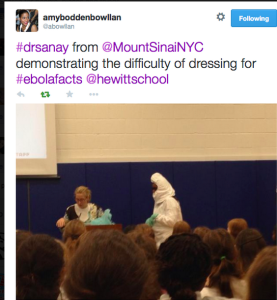Ebola has been a topic of conversation ever since the virus appeared in Liberia in mid-July. It has existed for decades, but this outbreak, which has killed nearly 5,000 people in 4 months, has been the worst outbreak in history.
On October 23, Dr. Joel Ernst, the Director of Infectious Disease and Immunology at NYU Medical Center, Dr. Emily Senay, an assistant clinical professor of Preventive Medicine at Mt. Sinai, and Rachel Granger, vice president of post-emergency programs at AmeriCares, spoke to Hewitt students about the virus.
Dr. Ernst studies and researches one of the major global infectious diseases, tuberculosis at the NYU medical school. His lab and research team continue to try to develop vaccines to treat strains of TB.
Dr. Senay is a physician, public health educator, broadcast journalist, and author. She is a professor at the Mount Sinai School of Medicine as well as a CBS medical correspondent for The Early Show. She has published a book called, “From Boys to Men: A Woman’s Guide to the Health of Husbands, Sons, Brothers, and Father.” Dr. Senay often speaks at panels and conferences on medical topics.
Rachel Granger oversees AmeriCares‘s long-term responses to all major disasters. She was among the first relief workers on the ground in Sri Lanka in the days after the Boxing Day Tsunami, coordinating emergency airlifts for survivors in the region. In 2010, Rachel headed one of the first teams of relief workers to arrive in Port-au-Prince, Haiti after the January 2010 earthquake. One year later, she was designing AmeriCares long-term recovery plan for survivors of the disaster in Japan, a plan that includes mental health and counseling services, rebuilding dental clinics, and restoring hope for survivors.
The three experts tried to clarify the convoluted facts the media forces down our throats.
Dr. Ernst tried to pacify the built-up anxiety shared by most New Yorkers by detailing the truths of Ebola. He explained that in reality there is a very small chance that the virus might mutate to become an airborne virus. It cannot simply be contracted by making any physical contact with someone infected. In order to contract the virus, you must make contact with an already-ill patient showing severe symptoms through that patient’s bodily fluids, such as blood, vomit, and sweat. Talking about the biology of the virus and its effects on humans, he reassured students that although the media might be portraying Ebola as an unstoppable, easily infective virus, it is something that we can take control of.
Dr. Senay described hospitals’ new treatment procedures. She explained how Mount Sinai, among other hospitals, has been training staff members and employees since August in terms of how to quarantine and assist those with Ebola. One of the most important things to keep in mind when dealing with Ebola patients is protecting oneself to prevent further spread of the disease, especially using Personal Protective Equipment, or PPE. She then proceeded to whip out a deconstructed Hazmat of sorts and described to us that treating those with Ebola is not just about having the right medicine, equipment and space, but it is also about the ostensibly smaller details, such as knowing how to put on and take off your PPE.
Finally, Ms. Granger from AmeriCares, spoke briefly about how AmeriCares is responding to the crisis in western Africa. She mentioned the lack of doctors and the weak health care system in these parts of Africa. It’s vital to turn our attention to the regions that have been greatly affected by this outbreak outside of the U.S., especially considering the unimaginable lack of healthcare services and treatment options. In Liberia, for example, there is one doctor for every 100,000 people.
Ebola is an important and serious threat that is and can affect humans on a global scale. Scientists and doctors worry that the disease cannot be contained and pan(dem)ic looks like a possibility. However, it is not inevitable, as the panelists have reassured us. We have taken and will continue to take steps to attack this virus; there is hope, and the portrayal of Ebola in the media might not be the most trustworthy source of facts.
